10.7 Renewable Energy – An Overview
Jeff Simpson and Carolina Londono Michel
Learning Objectives – By the end of this chapter, you should be able to do the following.
- Explain the differences between nonrenewable energy and renewable energy.
- List the primary renewable energy sources, explaining what they all have in common.
- Explain how most renewable energy really is stored solar energy.
- Describe the advantages and disadvantages of renewable energy.
In the previous section of this chapter, we looked at conventional energy sources – coal, petroleum (oil), natural gas and uranium (nuclear power.). All these sources have some things in common.
• They are all finite or nonrenewable. Once they are gone, they are gone.
• The most easily-obtained deposits of these sources have been extracted.
• We are now going deeper and farther to get more. This requires more energy and money and leaves a larger footprint.
• Fossil fuel molecules are important for making products, yet we continue to burn them.
• Because conventional energy sources are prized and unevenly distributed, they have been and continue to be a source of global tension and wars.
• The extraction and use of each of these comes at a cost on the environment, the economy, and society.
This second section of this unit will examine energy from renewable sources, ones that are naturally replenished on a human timescale.
• Hydroelectricity
• Solar Thermal
• Photovoltaic Energy
• Wind Power
• Geothermal Energy
• Ocean and Tidal Energy
• Biomass and Biofuels
• Hydrogen
• Conservation and Efficiency
• Storage
(Note: Biomass such as wood from trees is included here. It sometimes is classified as renewable, but wood is not sustainable at the rates that humans are deforesting the planet.)
Video 10.7.1 – Renewable Energy 101 (1:31)
In 2021, for the first time, solar and wind generated more electricity in the US than coal, though coal also is used to make steel and concrete.
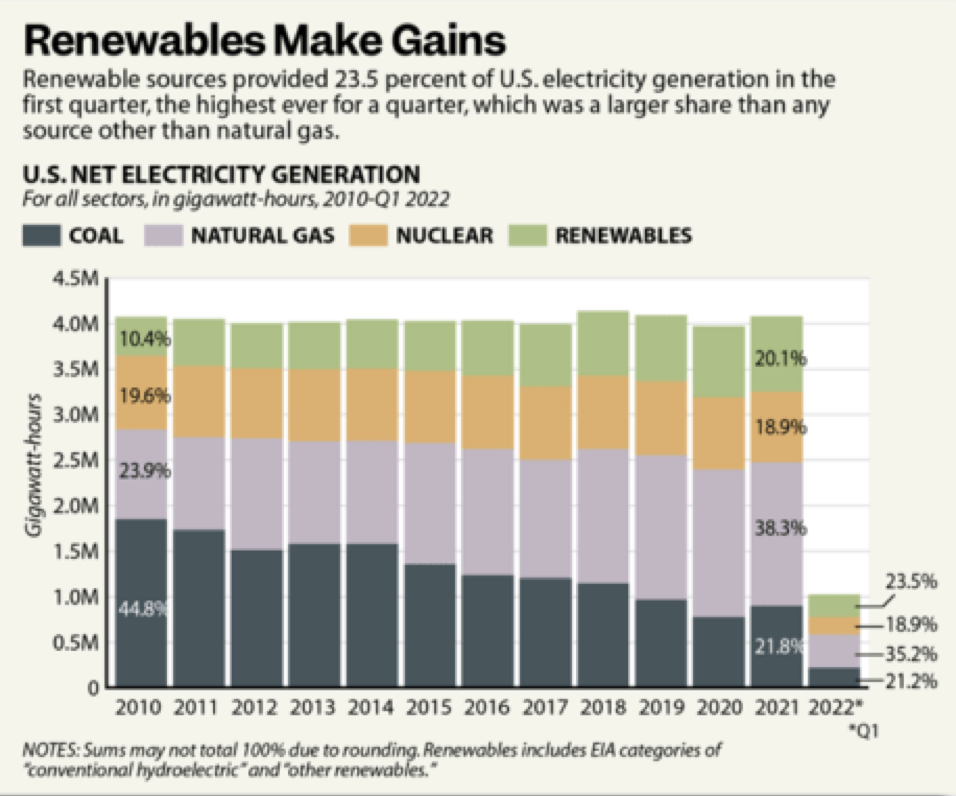
Since 2008, new additions to the US electrical grid have been over 50% renewables with that percentage hitting 85% in 2021. In April of 2022, for the first time, California briefly got 100% of its electricity from renewable sources. [LINK] This is just electricity and not fuels for transportation or industry, but this is a trend that will continue. It also is a trend that concerns the fossil fuel industry as they try to hang onto their “slice of the pie” and keep their hand in your pocket.
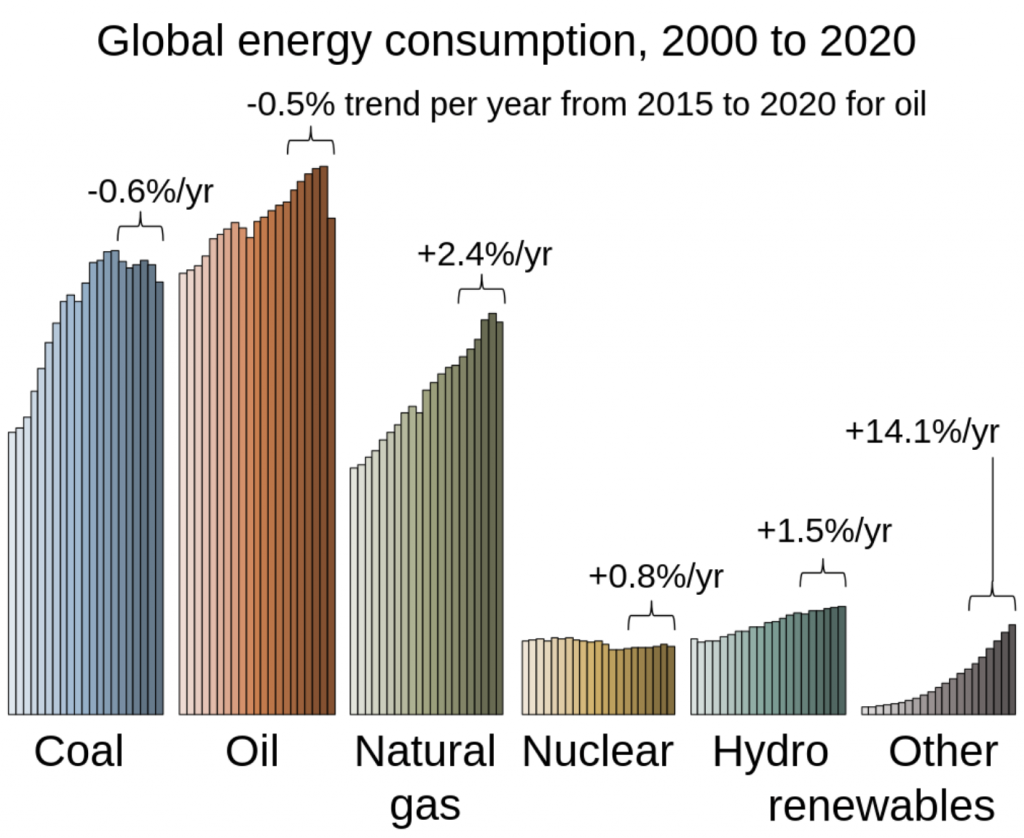
Globally there are over 11.5 million jobs associated with the renewable energy industries, with solar photovoltaics being the largest renewable employer. LINK
The price of fossil fuels can fluctuate widely depending on political conditions around the world. In 2022 natural gas prices more than doubled. This price volatility is not new.

The cost of a barrel of oil, too, can vary widely depending on economic and political stability. This instability is not new as shown in the figure below nor is it helpful for a country, though it is beneficial for fossil fuel investors.
As fossil fuels are concentrated in limited areas, many countries spend a lot of money on a military to ensure the free flow of oil “in the national interest”. In the case of the United States, this cost for protection and security is essentially a subsidy that totals a billion of dollars but is not considered a subsidy.
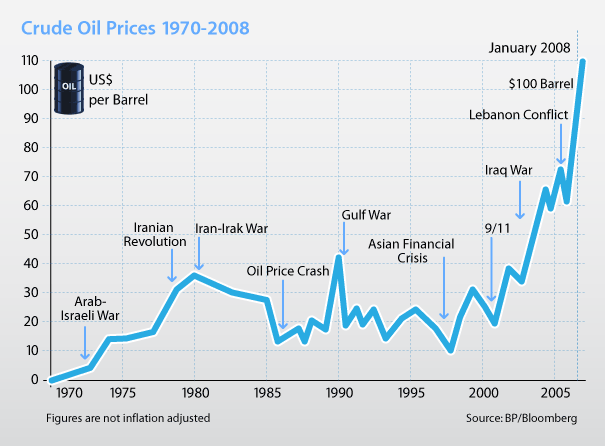
In contrast, as renewable energy depends on local resources, it is less affected by international conflict. Renewable energy creates local jobs. There are no emissions from renewable energy. In contrast, emissions from fossil fuels killed over 1,000,000 people around the world in 2017 with half of those deaths attributable to emissions from coal. LINK.
In contrast to the rising prices of limited nonrenewable resources, the cost of renewables is decreasing as show below.
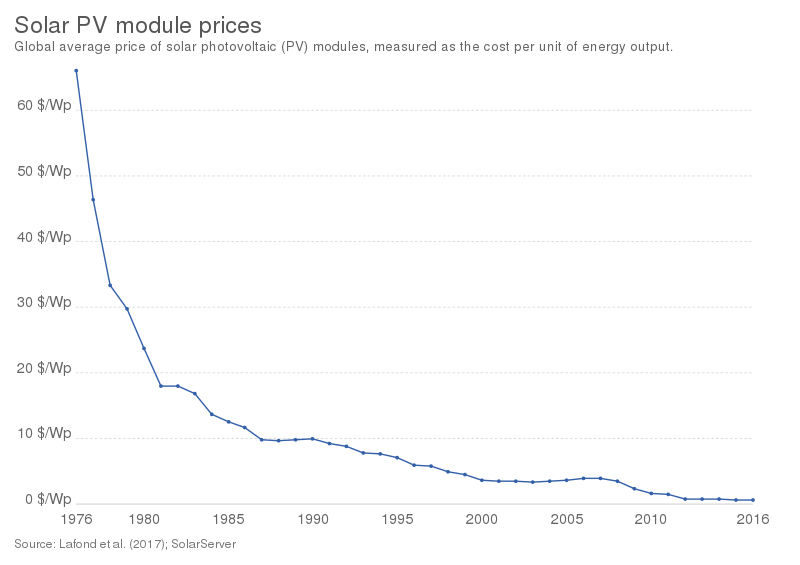
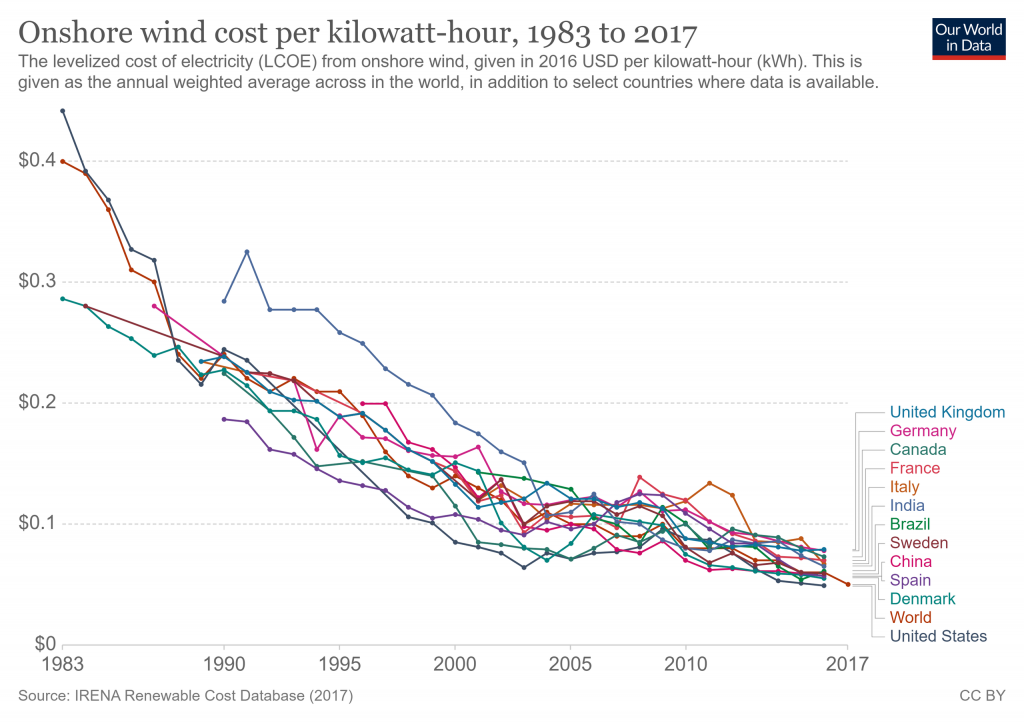
Renewable energy has two market advantages over fossil fuels. 1) The price for each kWh of energy is predictable; the cost of the wind and sun don’t change. Once the power plant is producing, the cost to generate each kWh is minimal. 2) The price for each kWh has been declining dramatically over the past few decades. As shown in the figure below, the unsubsidized cost for a unit of energy from wind, geothermal, or utility-scale solar is substantially less than a methane peaking plant, nuclear, or coal.
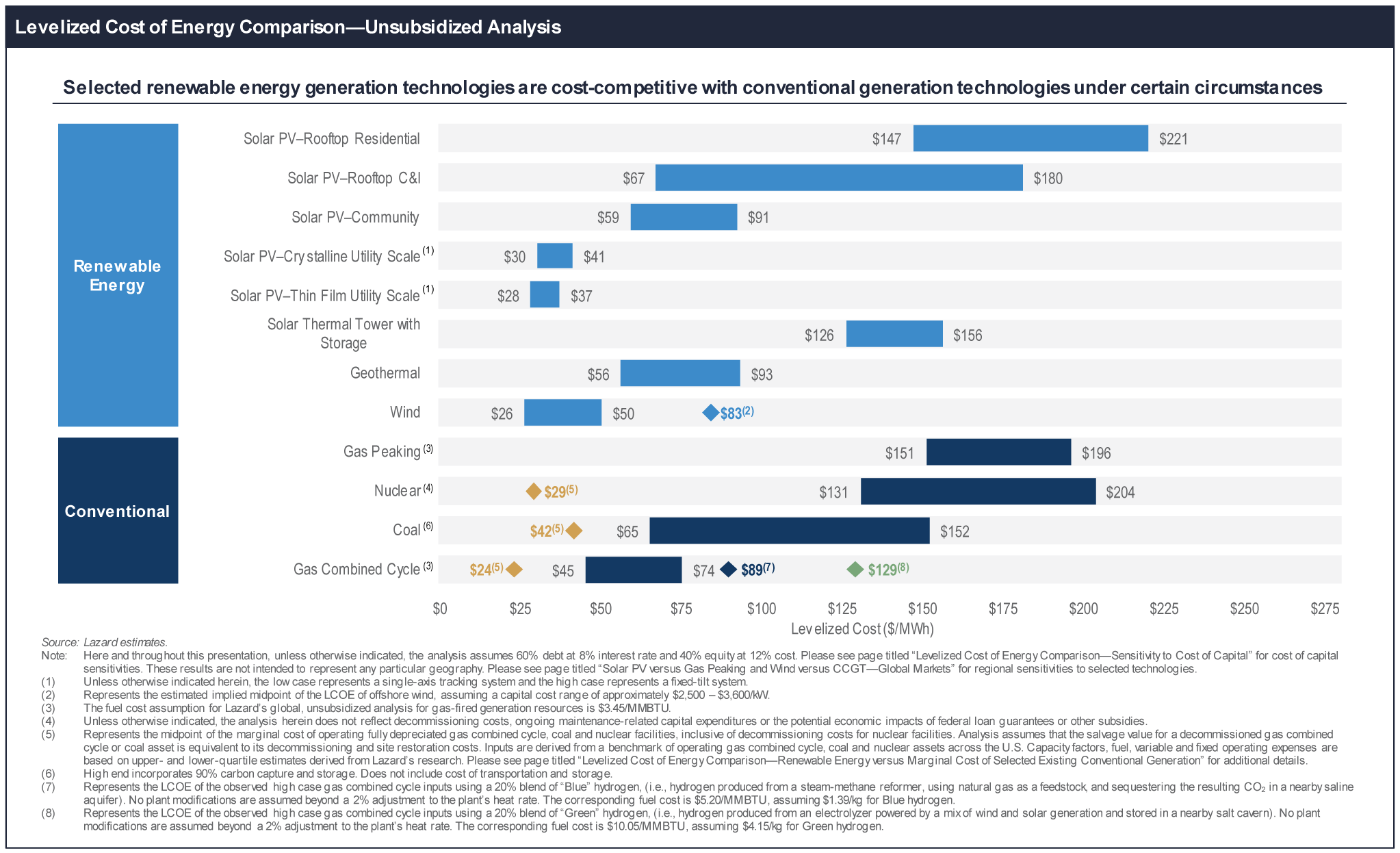
Many nations around the world already get more than 20% of their energy supply from renewables, with some generating over half their electricity from renewables. The state of Vermont in the US in 2021, got over 99% of its electricity from renewables. (LINK)
Most renewable energy sources originate directly or indirectly attributed to the sun. Solar power obviously comes from the sun. The wind that turns turbines exists because of unequal heating of Earth’s surface by… the sun. Hydropower, water turning turbines in dams, is indirect solar energy as the heat from the sun lifts the water molecules from the ocean where they condensed into rain and ended up in a reservoir. The sun provides the energy to grow plants, so biomass, too, is simply stored solar energy. Geothermal energy is the only non-solar renewable and hydrogen, depending on the source, may or may not be stored solar energy.. and may or may not be renewable. Each of these sources will be covered in turn.
The sun is expected to last another 4-5 billion years, making this a near-inexhaustible energy source.
While fossil fuels require large centralized plants often located far from cities (but not so much with methane plants) and large transmission lines, renewable energy is easier to decentralize. Homes, businesses, and isolated communities can use rooftop solar to produce electricity without being near a power plant or being connected to a grid.
This eliminates problems such as spills associated with the extraction and transportation of fossil fuels that are needed in order to supply these fossil fuels to those areas that are lacking.
Most renewable energy sources do not pollute the air with greenhouse gas emissions and other air pollutants associated with fossil fuels. This is especially important in combating climate change. (LINK)
Other than solar thermal, no water is required as a heat carrier in any of the renewable energy sources.
While naysayers claim that renewable energy won’t work, many major companies are run primarily on renewable energy, not waiting for our politicians to act. They have installed solar panels on their rooftops and signed power purchase agreements (PPAs) with renewable energy suppliers. Google has matched 100 percent of its global electricity use with purchases of renewable energy since 2017 when it was the mega-company to achieve this milestone. Google has agreements to buy power from more than 50 renewable energy projects, with a combined capacity of 5.5 gigawatts – about the same as a million solar rooftops. This means that for every kWh, Google used, they purchased 1 kWh from a renewable supplier. Their new goal is to run 24 hours a day 365 days a year on renewables alone. LINK
Video 10.7.2 – Renewables vs Fossil Fuels (17:29)
All energy production is a has environmental costs and tradeoffs, but the perfect should not be the enemy of the good.
There are clear advantages and disadvantages of renewables compared to fossil fuels.
Advantages of Renewable Energy
1. Electricity from utility scale plants is the cheapest in most places around the world.
2. Renewable energy is locally produced. Each kWh of renewable electricity that comes to your house to run your laptop does not require natural gas which is imported at great cost. This keeps more money in the local economy. For example, in 2015, each Arizonan sent over $1,4000 out of state for fossil fuels. (AriSEIA) This locally produced energy reduces the need for “national defense” to ensure the safe transport of fossil fuels around the world. This reduces international conflict.
3. Once the plant is built, unlike other sources of energy, the fuel is free.
4. Renewable energy can be placed closer to cities, on rooftops, or near remote communities not easily serviced by traditional power sources.
5. Being a distributed resource, renewable energy may reduce the need for transmission and distribution.
5. Renewables don’t produce greenhouse gases. They do not treat our atmosphere as a free dumping grounds. There are no major oil spills. This leads to a healthier environment, a healthier population, and lower healthcare costs.
6. Maintenance costs and operational costs for renewable energy plants are typically lower than for fossil fuels.
7. Unlike methane, coal, and nuclear plants, wind and PV solar energy sources do not require water for evaporative cooling. Geothermal does require water.
Disadvantages of Renewable Energy
1. Renewable energy sources often have lower efficiencies than fossil fuels, though when the fuel is free, this is not so important.
2. The capital cost – the cost to build the plant – may be more expensive per kWh, but as the fuel is free, renewables end up being cheaper.
3. Wind and solar are intermittent and, in the language of the utilities, not dispatchable. They can’t be turned off and on like a hydroelectric dam or fossil fuel power plant. The power must be used when it is produced or it must be stored and storage increasingly is being attached to solar and wind facilities.
4. Renewable energy may require more material such as copper and concrete per kWh than fossil fuels, though this material can be reused and recycled.

